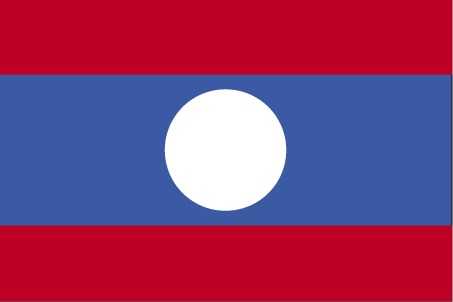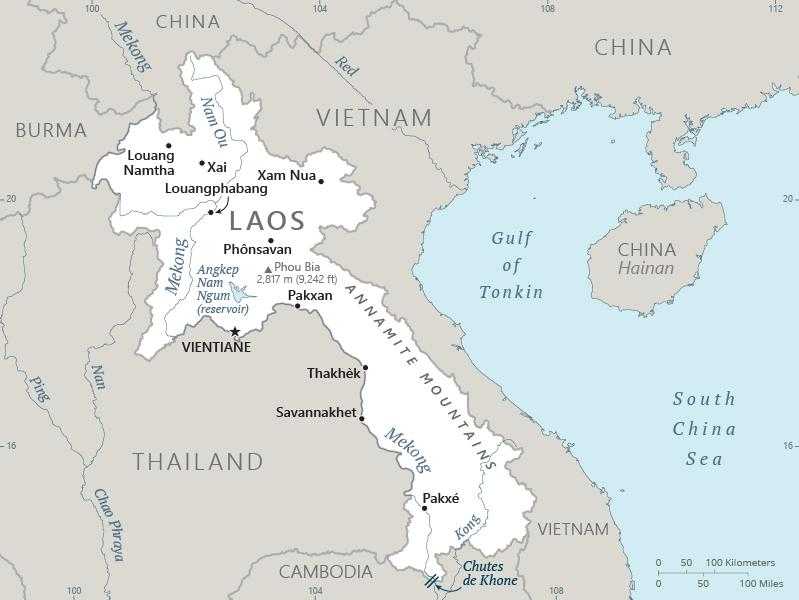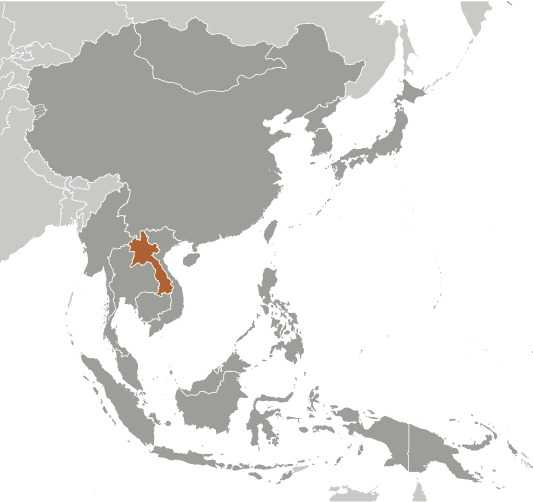Introduction
Background
Modern-day Laos has its roots in the ancient Lao kingdom of Lan Xang, established in the 14th century under King FA NGUM. For 300 years, Lan Xang had influence reaching into present-day Cambodia and Thailand, as well as over all of what is now Laos. After centuries of gradual decline, Laos came under the domination of Siam (Thailand) from the late 18th century until the late 19th century, when it became part of French Indochina. The Franco-Siamese Treaty of 1907 defined the current Lao border with Thailand. Following more than 15 years of civil war, the communist Pathet Lao took control of the government in 1975, ending a six-century-old monarchy and instituting a one party--the Lao People's Revolutionary Party--communist state. A gradual, limited return to private enterprise and the liberalization of foreign investment laws began in the late 1980s. Laos became a member of ASEAN in 1997 and the WTO in 2013.
In the 2010s, the country benefited from direct foreign investment, particularly in the natural resource and industry sectors. Construction of a number of large hydropower dams and expanding mining activities have also boosted the economy. Laos has retained its official commitment to communism and maintains close ties with its two communist neighbors, Vietnam and China, both of which continue to exert substantial political and economic influence on the country. China, for example, provided 70% of the funding for a $5.9 billion, 400-km railway line between the Chinese border and the capital Vientiane, which opened for operations in 2021. Laos financed the remaining 30% with loans from China. At the same time, Laos has expanded its economic reliance on the West and other Asian countries, such as Japan, Malaysia, Singapore, Taiwan, and Thailand. Nevertheless, despite steady economic growth for more than a decade, it remains one of Asia's poorest countries.
Visit the Definitions and Notes page to view a description of each topic.
Geography
Location
Southeastern Asia, northeast of Thailand, west of Vietnam
Geographic coordinates
18 00 N, 105 00 E
Map references
Southeast Asia
Area - comparative
about twice the size of Pennsylvania; slightly larger than Utah
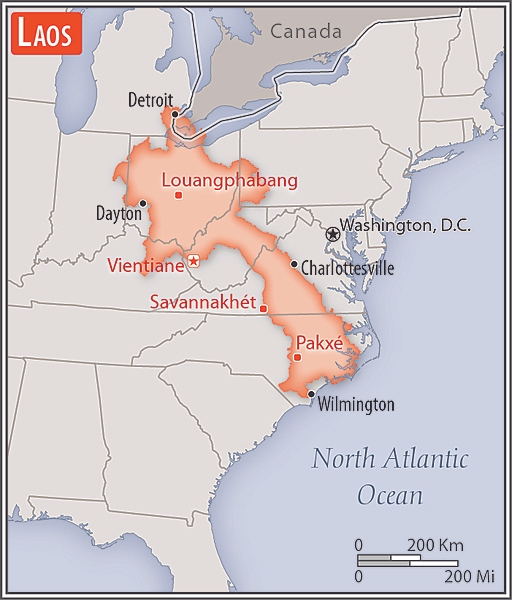
Land boundaries
total: 5,274 km
border countries (5): Burma 238 km; Cambodia 555 km; China 475 km; Thailand 1,845 km; Vietnam 2,161 km
Coastline
0 km (landlocked)
Maritime claims
none (landlocked)
Climate
tropical monsoon; rainy season (May to November); dry season (December to April)
Terrain
mostly rugged mountains; some plains and plateaus
Elevation
highest point: Phu Bia 2,817 m
lowest point: Mekong River 70 m
mean elevation: 710 m
Natural resources
timber, hydropower, gypsum, tin, gold, gemstones
Land use
agricultural land: 10.6% (2018 est.)
arable land: 6.2% (2018 est.)
permanent crops: 0.7% (2018 est.)
permanent pasture: 3.7% (2018 est.)
forest: 67.9% (2018 est.)
other: 21.5% (2018 est.)
Irrigated land
4,409 sq km (2020)
Major rivers (by length in km)
Mènam Khong (Mekong) (shared with China [s], Burma, Thailand, Cambodia, and Vietnam [m]) - 4,350 km
note – [s] after country name indicates river source; [m] after country name indicates river mouth
Major watersheds (area sq km)
Pacific Ocean drainage: Mekong (805,604 sq km)
Population distribution
most densely populated area is in and around the capital city of Vientiane; large communities are primarily found along the Mekong River along the southwestern border; overall density is considered one of the lowest in Southeast Asia
Natural hazards
floods, droughts
Geography - note
landlocked; most of the country is mountainous and thickly forested; the Mekong River forms a large part of the western boundary with Thailand
People and Society
Population
total: 7,953,556
male: 3,966,320
female: 3,987,236 (2024 est.)
comparison rankings: female 102; male 103; total 103
Nationality
noun: Lao(s) or Laotian(s)
adjective: Lao or Laotian
Ethnic groups
Lao 53.2%, Khmou 11%, Hmong 9.2%, Phouthay 3.4%, Tai 3.1%, Makong 2.5%, Katong 2.2%, Lue 2%, Akha 1.8%, other 11.6% (2015 est.)
note: the Laos Government officially recognizes 49 ethnic groups, but the total number of ethnic groups is estimated to be well over 200
Languages
Lao (official), French, English, various ethnic languages
major-language sample(s):
ແຫລ່ງທີ່ຂາດບໍ່ໄດ້ສຳລັບຂໍ້ມູນຕົ້ນຕໍ່” (Lao)
The World Factbook, the indispensable source for basic information.
Religions
Buddhist 64.7%, Christian 1.7%, none 31.4%, other/not stated 2.1% (2015 est.)
Demographic profile
Laos is a predominantly rural country with a youthful population – almost 55% of the population is under the age of 25. Its progress on health and development issues has been uneven geographically, among ethnic groups, and socioeconomically. Laos has made headway in poverty reduction, with the poverty rate almost halving from 46% in 1992/93 to 22% in 2012/13. Nevertheless, pronounced rural-urban disparities persist, and income inequality is rising. Poverty most affects populations in rural and highland areas, particularly ethnic minority groups.
The total fertility rate (TFR) has decreased markedly from around 6 births per woman on average in 1990 to approximately 2.8 in 2016, but it is still one of the highest in Southeast Asia. TFR is higher in rural and remote areas, among ethnic minority groups, the less-educated, and the poor; it is lower in urban areas and among the more educated and those with higher incomes. Although Laos’ mortality rates have improved substantially over the last few decades, the maternal mortality rate and childhood malnutrition remain at high levels. As fertility and mortality rates continue to decline, the proportion of Laos’ working-age population will increase, and its share of dependents will shrink. The age structure shift will provide Laos with the potential to realize a demographic dividend during the next few decades, if it can improve educational access and quality and gainfully employ its growing working-age population in productive sectors. Currently, Laos primary school enrollment is nearly universal, but the drop-out rate remains problematic. Secondary school enrollment has also increased but remains low, especially for girls.
Laos has historically been a country of emigration and internal displacement due to conflict and a weak economy. The Laos civil war (1953 – 1975) mainly caused internal displacement (numbering in the hundreds of thousands). Following the end of the Vietnam War in 1975, indigenous people in remote, war-struck areas were resettled and more than 300,000 people fled to Thailand to escape the communist regime that took power. The majority of those who sought refuge in Thailand ultimately were resettled in the US (mainly Hmong who fought with US forces), and lesser numbers went to France, Canada, and Australia.
The Laos Government carried out resettlement programs between the mid-1980s and mid-1990s to relocate ethnic minority groups from the rural northern highlands to development areas in the lowlands ostensibly to alleviate poverty, make basic services more accessible, eliminate slash-and-burn agriculture and opium production, integrate ethnic minorities, and control rebel groups (including Hmong insurgents). For many, however, resettlement has exacerbated poverty, led to the loss of livelihoods, and increased food insecurity and mortality rates. As the resettlement programs started to wane in the second half of the 1990s, migration from the northern highlands to urban centers – chiefly the capital Vientiane – to pursue better jobs in the growing manufacturing and service sectors became the main type of relocation. Migration of villagers from the south seeking work in neighboring Thailand also increased. Thailand is the main international migration destination for Laotians because of the greater availability of jobs and higher pay than at home; nearly a million Laotian migrants were estimated to live in Thailand as of 2015.
Age structure
0-14 years: 30.1% (male 1,214,429/female 1,181,845)
15-64 years: 65% (male 2,573,668/female 2,599,957)
65 years and over: 4.8% (2024 est.) (male 178,223/female 205,434)
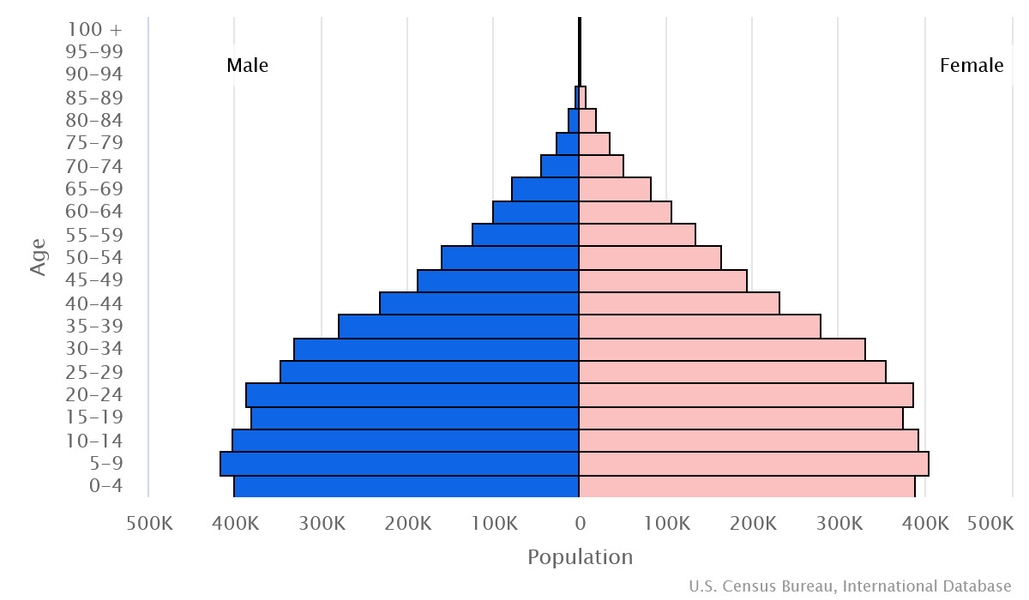
Dependency ratios
total dependency ratio: 54.7
youth dependency ratio: 48
elderly dependency ratio: 6.7
potential support ratio: 14.8 (2021 est.)
Median age
total: 25.4 years (2024 est.)
male: 25 years
female: 25.7 years
comparison ranking: total 170
Population distribution
most densely populated area is in and around the capital city of Vientiane; large communities are primarily found along the Mekong River along the southwestern border; overall density is considered one of the lowest in Southeast Asia
Urbanization
urban population: 38.2% of total population (2023)
rate of urbanization: 2.99% annual rate of change (2020-25 est.)
Major urban areas - population
721,000 VIENTIANE (capital) (2023)
Sex ratio
at birth: 1.04 male(s)/female
0-14 years: 1.03 male(s)/female
15-64 years: 0.99 male(s)/female
65 years and over: 0.87 male(s)/female
total population: 1 male(s)/female (2024 est.)
Infant mortality rate
total: 35.4 deaths/1,000 live births (2024 est.)
male: 39.1 deaths/1,000 live births
female: 31.6 deaths/1,000 live births
comparison ranking: total 38
Life expectancy at birth
total population: 69 years (2024 est.)
male: 67.4 years
female: 70.7 years
comparison ranking: total population 183
Gross reproduction rate
1.1 (2024 est.)
Contraceptive prevalence rate
54.1% (2017)
Drinking water source
improved: urban: 97.1% of population
rural: 84.1% of population
total: 88.8% of population
unimproved: urban: 2.9% of population
rural: 15.9% of population
total: 11.2% of population (2020 est.)
Current health expenditure
2.7% of GDP (2020)
Physician density
0.35 physicians/1,000 population (2020)
Hospital bed density
1.5 beds/1,000 population (2012)
Sanitation facility access
improved: urban: 100% of population
rural: 72% of population
total: 82.2% of population
unimproved: urban: 0% of population
rural: 28% of population
total: 17.8% of population (2020 est.)
Major infectious diseases
degree of risk: very high (2023)
food or waterborne diseases: bacterial and protozoal diarrhea, hepatitis A, and typhoid fever
vectorborne diseases: dengue fever, malaria, and sexually transmitted diseases: hepatitis B (2024)
Alcohol consumption per capita
total: 8.15 liters of pure alcohol (2019 est.)
beer: 3.62 liters of pure alcohol (2019 est.)
wine: 0.07 liters of pure alcohol (2019 est.)
spirits: 4.46 liters of pure alcohol (2019 est.)
other alcohols: 0 liters of pure alcohol (2019 est.)
comparison ranking: total 42
Tobacco use
total: 31.8% (2020 est.)
male: 53.3% (2020 est.)
female: 10.3% (2020 est.)
comparison ranking: total 21
Currently married women (ages 15-49)
60.1% (2023 est.)
Child marriage
women married by age 15: 7.1%
women married by age 18: 32.7%
men married by age 18: 10.8% (2017 est.)
Literacy
definition: age 15 and over can read and write
total population: 87.1%
male: 91.4%
female: 81.4% (2021)
School life expectancy (primary to tertiary education)
total: 10 years
male: 10 years
female: 10 years (2020)
Environment
Environment - current issues
unexploded ordnance; deforestation; soil erosion; loss of biodiversity; water pollution, most of the population does not have access to potable water
Environment - international agreements
party to: Biodiversity, Climate Change, Climate Change-Kyoto Protocol, Climate Change-Paris Agreement, Comprehensive Nuclear Test Ban, Desertification, Endangered Species, Environmental Modification, Hazardous Wastes, Law of the Sea, Nuclear Test Ban, Ozone Layer Protection, Wetlands, Whaling
signed, but not ratified: none of the selected agreements
Climate
tropical monsoon; rainy season (May to November); dry season (December to April)
Land use
agricultural land: 10.6% (2018 est.)
arable land: 6.2% (2018 est.)
permanent crops: 0.7% (2018 est.)
permanent pasture: 3.7% (2018 est.)
forest: 67.9% (2018 est.)
other: 21.5% (2018 est.)
Urbanization
urban population: 38.2% of total population (2023)
rate of urbanization: 2.99% annual rate of change (2020-25 est.)
Air pollutants
particulate matter emissions: 21.15 micrograms per cubic meter (2019 est.)
carbon dioxide emissions: 17.76 megatons (2016 est.)
methane emissions: 9 megatons (2020 est.)
Waste and recycling
municipal solid waste generated annually: 351,900 tons (2015 est.)
municipal solid waste recycled annually: 35,190 tons (2015 est.)
percent of municipal solid waste recycled: 10% (2015 est.)
Major rivers (by length in km)
Mènam Khong (Mekong) (shared with China [s], Burma, Thailand, Cambodia, and Vietnam [m]) - 4,350 km
note – [s] after country name indicates river source; [m] after country name indicates river mouth
Major watersheds (area sq km)
Pacific Ocean drainage: Mekong (805,604 sq km)
Total water withdrawal
municipal: 130 million cubic meters (2020 est.)
industrial: 170 million cubic meters (2020 est.)
agricultural: 7.05 billion cubic meters (2020 est.)
Total renewable water resources
333.5 billion cubic meters (2020 est.)
Government
Country name
conventional long form: Lao People's Democratic Republic
conventional short form: Laos
local long form: Sathalanalat Paxathipatai Paxaxon Lao
local short form: Mueang Lao (unofficial)
abbreviation: Lao PDR
etymology: name means "Land of the Lao [people]"
Government type
communist party-led state
Capital
name: Vientiane (Viangchan)
geographic coordinates: 17 58 N, 102 36 E
time difference: UTC+7 (12 hours ahead of Washington, DC, during Standard Time)
etymology: the meaning in Pali, a Buddhist liturgical language, is "city of sandalwood"
Administrative divisions
17 provinces (khoueng, singular and plural) and 1 prefecture* (kampheng nakhon); Attapu, Bokeo, Bolikhamxay, Champasak, Houaphanh, Khammouan, Louangnamtha, Louangphabang (Luang Prabang), Oudomxai, Phongsali, Salavan, Savannakhet, Viangchan (Vientiane)*, Viangchan, Xaignabouli, Xaisomboun, Xekong, Xiangkhouang
Independence
19 July 1949 (from France by the Franco-Lao General Convention); 22 October 1953 (Franco-Lao Treaty recognizes full independence)
National holiday
Republic Day (National Day), 2 December (1975)
Constitution
history: previous 1947 (preindependence); latest promulgated 13-15 August 1991
amendments: proposed by the National Assembly; passage requires at least two-thirds majority vote of the Assembly membership and promulgation by the president of the republic; amended 2003, 2015
Legal system
civil law system similar in form to the French system
International law organization participation
has not submitted an ICJ jurisdiction declaration; non-party state to the ICCt
Citizenship
citizenship by birth: no
citizenship by descent only: at least one parent must be a citizen of Laos
dual citizenship recognized: no
residency requirement for naturalization: 10 years
Suffrage
18 years of age; universal
Executive branch
chief of state: President THONGLOUN Sisoulith (since 22 March 2021)
head of government: Prime Minister SONEXAY Siphandon (since 30 December 2022)
cabinet: Council of Ministers appointed by the president and approved by the National Assembly
elections/appointments: president and vice president indirectly elected by the National Assembly for a 5-year term (no term limits); election last held on 22 March 2021 (next to be held in March 2026); prime minister nominated by the president, elected by the National Assembly for a 5-year term
election results:
2021: THONGLOUN Sisoulith (LPRP) elected president; National Assembly vote - 161-1; PHANKHAM Viphavanh (LPRP) elected prime minister; National Assembly vote - 158-3
2016: BOUNNHANG Vorachit (LPRP) elected president; percent of National Assembly vote - NA; THONGLOUN Sisoulith (LPRP) elected prime minister; percent of National Assembly vote - NA
Legislative branch
description: unicameral National Assembly or Sapha Heng Xat (164 seats; members directly elected in multi-seat constituencies by simple majority vote from candidate lists provided by the Lao People's Revolutionary Party; members serve 5-year terms)
elections: last held on 21 February 2021 (next to be held in 2026)
election results: percent of vote by party - NA; seats by party - LPRP 158, independent 6; composition - men 128, women 36, percentage women 22%
Judicial branch
highest court(s): People's Supreme Court (consists of the court president and organized into criminal, civil, administrative, commercial, family, and juvenile chambers, each with a vice president and several judges)
judge selection and term of office: president of People's Supreme Court appointed by the National Assembly upon the recommendation of the president of the republic for a 5-year term; vice presidents of the People's Supreme Court appointed by the president of the republic upon the recommendation of the National Assembly; appointment of chamber judges NA; tenure of court vice presidents and chamber judges NA
subordinate courts: appellate courts; provincial, municipal, district, and military courts
Political parties and leaders
Lao People's Revolutionary Party or LPRP [THONGLOUN Sisoulith]
note: other parties proscribed
International organization participation
ADB, ARF, ASEAN, CP, EAS, FAO, G-77, IAEA, IBRD, ICAO, ICRM, IDA, IFAD, IFC, IFRCS, ILO, IMF, Interpol, IOC, IPU, ISO (subscriber), ITU, MIGA, NAM, OIF, OPCW, PCA, UN, UNCTAD, UNESCO, UNIDO, UNWTO, UPU, WCO, WFTU (NGOs), WHO, WIPO, WMO, WTO
Diplomatic representation in the US
chief of mission: Ambassador Sisavath INPHACHANH (since 7 June 2022)
chancery: 2222 S Street NW, Washington, DC 20008
telephone: [1] (202) 332-6416
FAX: [1] (202) 332-4923
email address and website:
embasslao@gmail.com
https://laoembassy.com/
Diplomatic representation from the US
chief of mission: Ambassador (vacant); Chargé d’Affaires Michelle OUTLAW (since August 2023)
embassy: Ban Somvang Tai, Thadeua Road, Km 9, Hatsayfong District, Vientiane
mailing address: 4350 Vientiane Place, Washington DC 20521-4350
telephone: [856] 21-48-7000
FAX: [856] 21-48-7040
email address and website:
CONSLAO@state.gov
https://la.usembassy.gov/
Flag description
three horizontal bands of red (top), blue (double width), and red with a large white disk centered in the blue band; the red bands recall the blood shed for liberation; the blue band represents the Mekong River and prosperity; the white disk symbolizes the full moon against the Mekong River, but also signifies the unity of the people under the Lao People's Revolutionary Party, as well as the country's bright future
National symbol(s)
elephant; national colors: red, white, blue
National anthem
name: "Pheng Xat Lao" (Hymn of the Lao People)
lyrics/music: SISANA Sisane/THONGDY Sounthonevichit
note: music adopted 1945, lyrics adopted 1975; the anthem's lyrics were changed following the 1975 Communist revolution that overthrew the monarchy
National heritage
total World Heritage Sites: 3 (all cultural)
selected World Heritage Site locales: Town of Luangphrabang; Vat Phou and Associated Ancient Settlements; Megalithic Jar Sites in Xiengkhuang - Plain of Jars
Economy
Economic overview
lower middle-income, socialist Southeast Asian economy; one of the fastest growing economies; declining but still high poverty; natural resource rich; new anticorruption efforts; already high and growing public debt; service sector hit hard by COVID-19
Real GDP (purchasing power parity)
$64.173 billion (2023 est.)
$61.856 billion (2022 est.)
$60.225 billion (2021 est.)
note: data in 2021 dollars
comparison ranking: 112
Real GDP growth rate
3.75% (2023 est.)
2.71% (2022 est.)
2.53% (2021 est.)
note: annual GDP % growth based on constant local currency
comparison ranking: 85
Real GDP per capita
$8,400 (2023 est.)
$8,200 (2022 est.)
$8,100 (2021 est.)
note: data in 2021 dollars
comparison ranking: 155
GDP (official exchange rate)
$15.843 billion (2023 est.)
note: data in current dollars at official exchange rate
Inflation rate (consumer prices)
31.23% (2023 est.)
22.96% (2022 est.)
3.76% (2021 est.)
note: annual % change based on consumer prices
comparison ranking: 209
Credit ratings
Fitch rating: CCC (2020)
Moody's rating: Caa2 (2020)
note: the year refers to the year in which the current credit rating was first obtained.
GDP - composition, by sector of origin
agriculture: 20.9% (2017 est.)
industry: 33.2% (2017 est.)
services: 45.9% (2017 est.)
comparison rankings: services 195; industry 56; agriculture 44
GDP - composition, by end use
household consumption: 63.7% (2017 est.)
government consumption: 14.1% (2017 est.)
investment in fixed capital: 30.9% (2017 est.)
investment in inventories: 3.1% (2017 est.)
exports of goods and services: 34.6% (2017 est.)
imports of goods and services: -43.2% (2017 est.)
Agricultural products
cassava, root vegetables, rice, sugarcane, vegetables, bananas, maize, rubber, coffee, watermelons (2022)
note: top ten agricultural products based on tonnage
Industries
mining (copper, tin, gold, gypsum); timber, electric power, agricultural processing, rubber, construction, garments, cement, tourism
Industrial production growth rate
2.61% (2023 est.)
note: annual % change in industrial value added based on constant local currency
comparison ranking: 111
Labor force
3.174 million (2023 est.)
note: number of people ages 15 or older who are employed or seeking work
comparison ranking: 105
Unemployment rate
1.18% (2023 est.)
1.21% (2022 est.)
2% (2021 est.)
note: % of labor force seeking employment
comparison ranking: 12
Youth unemployment rate (ages 15-24)
total: 3.3% (2021 est.)
male: 3.4%
female: 3.2%
comparison ranking: total 196
Population below poverty line
18.3% (2018 est.)
note: % of population with income below national poverty line
Gini Index coefficient - distribution of family income
38.8 (2018 est.)
note: index (0-100) of income distribution; higher values represent greater inequality
comparison ranking: 61
Average household expenditures
on food: 50.6% of household expenditures (2021 est.)
on alcohol and tobacco: 10.8% of household expenditures (2021 est.)
Household income or consumption by percentage share
lowest 10%: 3% (2018 est.)
highest 10%: 31.2% (2018 est.)
note: % share of income accruing to lowest and highest 10% of population
Remittances
1.42% of GDP (2023 est.)
1.55% of GDP (2022 est.)
1.17% of GDP (2021 est.)
note: personal transfers and compensation between resident and non-resident individuals/households/entities
Budget
revenues: $2.896 billion (2019 est.)
expenditures: $3.839 billion (2019 est.)
Current account balance
-$10.954 million (2022 est.)
$446.505 million (2021 est.)
-$230.973 million (2020 est.)
note: balance of payments - net trade and primary/secondary income in current dollars
comparison ranking: 84
Exports
$8.604 billion (2022 est.)
$7.82 billion (2021 est.)
$6.461 billion (2020 est.)
note: balance of payments - exports of goods and services in current dollars
comparison ranking: 123
Exports - partners
Thailand 35%, China 29%, Vietnam 10%, Australia 4%, US 3% (2022)
note: top five export partners based on percentage share of exports
Exports - commodities
electricity, gold, rubber, fertilizers, paper (2022)
note: top five export commodities based on value in dollars
Imports
$7.772 billion (2022 est.)
$6.527 billion (2021 est.)
$5.816 billion (2020 est.)
note: balance of payments - imports of goods and services in current dollars
comparison ranking: 133
Imports - partners
Thailand 56%, China 26%, Vietnam 8%, Malaysia 3%, Singapore 1% (2022)
note: top five import partners based on percentage share of imports
Imports - commodities
refined petroleum, gold, electrical machinery, raw sugar, plastic products (2022)
note: top five import commodities based on value in dollars
Reserves of foreign exchange and gold
$1.77 billion (2023 est.)
$1.576 billion (2022 est.)
$1.951 billion (2021 est.)
note: holdings of gold (year-end prices)/foreign exchange/special drawing rights in current dollars
comparison ranking: 136
Debt - external
$14.9 billion (31 December 2017 est.)
$12.9 billion (31 December 2016 est.)
comparison ranking: 103
Exchange rates
kips (LAK) per US dollar -
Exchange rates:
17,688.874 (2023 est.)
14,035.227 (2022 est.)
9,697.916 (2021 est.)
9,045.788 (2020 est.)
8,679.409 (2019 est.)
Energy
Electricity access
electrification - total population: 100% (2022 est.)
Electricity
installed generating capacity: 12.222 million kW (2022 est.)
consumption: 8.829 billion kWh (2022 est.)
exports: 35.113 billion kWh (2022 est.)
imports: 1.365 billion kWh (2022 est.)
transmission/distribution losses: 3.376 billion kWh (2022 est.)
comparison rankings: transmission/distribution losses 144; imports 71; exports 5; consumption 110; installed generating capacity 58
Electricity generation sources
fossil fuels: 27% of total installed capacity (2022 est.)
solar: 0.1% of total installed capacity (2022 est.)
hydroelectricity: 72.7% of total installed capacity (2022 est.)
biomass and waste: 0.2% of total installed capacity (2022 est.)
Coal
production: 14.845 million metric tons (2022 est.)
consumption: 13.691 million metric tons (2022 est.)
exports: 845,000 metric tons (2022 est.)
imports: 6,000 metric tons (2022 est.)
proven reserves: 62 million metric tons (2022 est.)
Petroleum
refined petroleum consumption: 24,000 bbl/day (2022 est.)
Carbon dioxide emissions
20.151 million metric tonnes of CO2 (2022 est.)
from coal and metallurgical coke: 16.499 million metric tonnes of CO2 (2022 est.)
from petroleum and other liquids: 3.652 million metric tonnes of CO2 (2022 est.)
comparison ranking: total emissions 86
Communications
Telephones - fixed lines
total subscriptions: 1.3 million (2021 est.)
subscriptions per 100 inhabitants: 18 (2021 est.)
comparison ranking: total subscriptions 62
Telephones - mobile cellular
total subscriptions: 4.823 million (2021 est.)
subscriptions per 100 inhabitants: 65 (2021 est.)
comparison ranking: total subscriptions 125
Telecommunication systems
general assessment: Laos joined the World Trade Organization (WTO) in 2013; one of the conditions of admittance was to establish an independent regulator for its telecom sector within two years; the government had committed to do so by February 2015 as part of the accession agreement; there still has been no sign of any firm plans being made to create an independent regulatory body; the Ministry of Technology and Communications retains the primary role in regulating the country’s telecom market; with the government also having a financial stake (in part or in whole) in every one of the major fixed-line and mobile operators, the MPT’s position and decision-making is far from what could be considered independent; sufficient returns on investment cannot be guaranteed with such strict pricing controls as well as the potential for political interference; fixed-line and mobile penetration levels have, as a result, remained much lower than what’s seen in neighboring South East Asian markets; there are signs of growth in the mobile broadband segment as LTE network coverage slowly widens and, more recently, the country’s first 5G services start to come on stream; residents in the capital will at least be able to enjoy high-speed services in the near future, while the rest of the country waits patiently to catch up with the rest of the world. (2022)
domestic: fixed-line nearly 18 per 100 and 65 per 100 for mobile-cellular subscriptions (2021)
international: country code - 856; satellite earth station - 1 Intersputnik (Indian Ocean region) and a second to be developed by China
Broadcast media
6 TV stations operating out of Vientiane - 3 government-operated and the others commercial; 17 provincial stations operating with nearly all programming relayed via satellite from the government-operated stations in Vientiane; Chinese and Vietnamese programming relayed via satellite from Lao National TV; broadcasts available from stations in Thailand and Vietnam in border areas; multi-channel satellite and cable TV systems provide access to a wide range of foreign stations; state-controlled radio with state-operated Lao National Radio (LNR) broadcasting on 5 frequencies - 1 AM, 1 SW, and 3 FM; LNR's AM and FM programs are relayed via satellite constituting a large part of the programming schedules of the provincial radio stations; Thai radio broadcasts available in border areas and transmissions of multiple international broadcasters are also accessible
Internet users
total: 4.588 million (2021 est.)
percent of population: 62% (2021 est.)
comparison ranking: total 103
Broadband - fixed subscriptions
total: 128,000 (2020 est.)
subscriptions per 100 inhabitants: 2 (2020 est.)
comparison ranking: total 126
Transportation
National air transport system
number of registered air carriers: 1 (2020)
inventory of registered aircraft operated by air carriers: 12
annual passenger traffic on registered air carriers: 1,251,961 (2018)
annual freight traffic on registered air carriers: 1.53 million (2018) mt-km
Pipelines
540 km refined products (2013)
Railways
total: 422 km (2023)
standard gauge: 422 km (2023) 1.435-m gauge (422 km overhead electrification)
comparison ranking: total 120
Military and Security
Military and security forces
Lao People's Armed Forces (LPAF): Lao People's Army (LPA, includes Riverine Force), Lao People's Air Force (LPAF), Self-Defense Militia Forces (2024)
note: the Ministry of Public Security maintains internal security and is responsible for law enforcement; it oversees local, traffic, immigration, and security police, village police auxiliaries, and other armed police units
Military expenditures
0.2% of GDP (2019 est.)
0.2% of GDP (2018 est.)
0.2% of GDP (2017 est.)
0.2% of GDP (2016 est.)
0.2% of GDP (2015 est.)
comparison ranking: 166
Military and security service personnel strengths
limited and varied information; estimated 30,000 active-duty troops (26,000 Army; 4,000 Air Force) (2023)
Military equipment inventories and acquisitions
the LPAF is armed largely with Soviet-era weapons; in recent years, China and Russia have been the leading suppliers of military equipment to Laos (2023)
Military service age and obligation
18 years of age for compulsory or voluntary military service; minimum 18-month service obligation (2023)
Military - note
the LPAF’s primary missions are border and internal security, including counterinsurgency and counterterrorism; Vietnam is the military's primary security partner, although in recent years, Laos has expanded defense ties with China and Russia (2023)
Transnational Issues
Illicit drugs
Laos remains a key transit route for drug trafficking and the movement of precursor chemicals; opium produced is typically smuggled out of the country and refined elsewhere and not trafficked in significant quantities to the United States

